How to Make the Most of Pool Sessions
Mention “pool session” and the first image that pops into most kayakers minds is a class in how to roll. For whitewater enthusiasts, that’s probably the correct assumption, but for the touring/recreational kayaker, a pool is also the perfect venue for honing many more skills, both basic and advanced.
The warm, calm and clearly protected waters of a pool enables a paddler to concentrate on learning new techniques without having to also focus on comfort and threatening situations. That said, never assume that your pool session has given you command of an exercise or procedure over actual open-water experience and real-life situations. Pool sessions are a classroom platform for learning in very controlled conditions.
Whether scouting out an existing on-water pool program or contemplating organizing your own, consider the advantages that such ‘hands-on’ session offer a paddler - from novice to skill-honing, advanced kayaker. It’s an opportunity to learn basic skills and be able to practice them as part of an introductory pool session. Pool sessions are also valuable for enabling you to test out a new boat or associated gear, gauge your level of proficiency at procedures you may not yet fully master, or simply further hone those skills you do have.
Besides any special requirements the pool’s administrators may have, you should prepare yourself and your gear for a well-rounded and active session on and in the water. That means wearing the same clothing and gear in which you intend to paddle. Initially you can be taught the basic in a swim suit, with or without a PFD. This will guide you through the motions; development and refinement of any skills comes later. At some stage in your pool session experience, you should wear what you’ll have on while kayaking - to ensure that gear won’t be restrictive during an actual procedure - especially when engaged in a rescue effort.
For the protection of others, the pool and your own craft, it’s a good idea to pad both the bow and stern of your kayak. A small section of a closed-cell foam pad, even a common sponge, folded around the ends of your boat and wrapped with duct tape makes for a simple ‘bumper’ during the session. Requiring that each paddler in a boat has a spotter mate and limiting the number of boats in the pool also help keep collisions to a minimum.
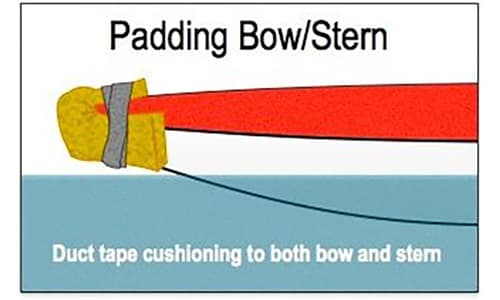
TAHE 10'6 & 11'6 SUP-YAK Inflatables
2-in-1 Kayak & Paddle Board complete packages for single or tandem use.
It’s important to be introduced to, and then practice skills in a boat that is most similar to your own. Again, you can advance yourself through sessions by being first introduced to new procedures in a loaner kayak. However, practicing in a boat that is the same style, length, beam and weight of what you’ll ultimately be paddling will give you a more realistic ‘feel’ throughout your learning sessions - as well as your developed response to the actions of a familiar boat.
Be careful not to get too ambitious if you are a beginner. There’s a lot to take in at first: newly introduced skills you may not have even considered, and perhaps more importantly, “un”learning some bad habits you may have brought to the pool session with you. For some, just becoming comfortable with one’s boat is a critical goal for early on-water kayak work.
The complexity and importance of self rescue procedures should be an advanced offering in a pool program. It can be done the same night, but only after attendees are comfortable and somewhat proficient in the basics.
BECOME “ONE” - Just sitting confidently within your cockpit can be the first reassuring sense you have as a new kayaker. Once your body - and mind - learns how to adjust themselves to the constant micro-shifting of the boat, you can concentrate on other balancing challenges that are part of many kayak moves. Remember how it felt as a kid when you were first learning to ride your bicycle?
PADDLING STROKES - While there’s not much room in a pool for forays along the water, learning proper paddle positions and stroke sequences can be at least introduced and short tutorials demonstrated. Emphasizing proper hand position, paddle angle, feathered/unfeathered and perhaps minimal movement work on sculling can all be practiced in a well-managed pool setting.
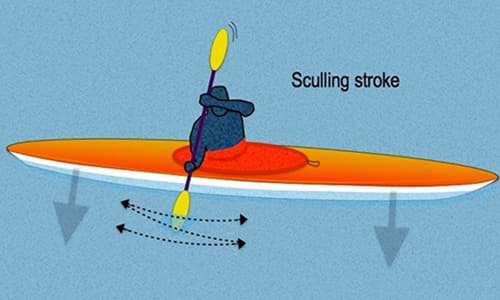
J-LEAN - This is simply learning to maintain your Center of Gravity over your boat when the hull leans to one side or the other. This hooked or J-shaped body posture helps you maintain a centered, upright balance for many maneuvers. You can practice this, even while you sit for other sessions. It’s a good way to push the limits of your boat before it dumps you over.
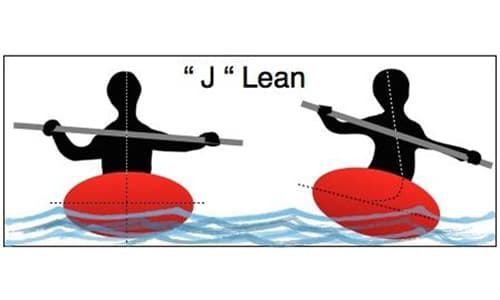
POOL EDGE EXERCISES - You can extend your J-Lean comfort zone by bracing yourself alongside the pool. With your arm extended and fingers poised on the edge, you can push the threshold of your lean several times without loosing it. Poolside support is also an aid in practicing the hip snap you’ll need as part of the upright processes you’ll learn during rescue sessions that include rolling and assisted recoveries.

CAPSIZE-UNDERWATER EXIT - This, to me, is one of the most critical exercises one can learn as a kayaker. It’s the very first thing I have paddlers do before we start in on any kind of rescue-related skill session. There is always at least one kayaker who is totally intimidated by capsizing. It’s perhaps based upon the same fears held by those who hate to use spray skirts because they find them too restrictive.
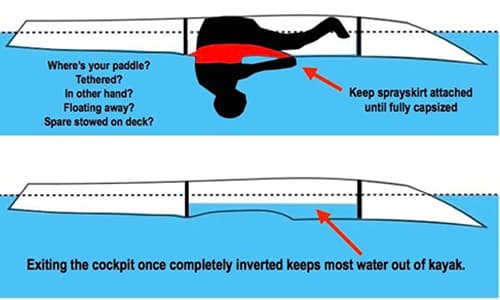
Controlled capsize exercises can help a reluctant paddler experience how easy it is to escape from an overturned boat. It also can show how using a spray skirt can keep more water out of your boat as well. Introducing the use of sprayskirts is a vital, beneficial offering among pool exercises.
Between the basics of beginning kayaking and the advanced focus of rolling techniques is a middle tier of pool programming: Self and Group Re-Entry procedures.
Self rescue is a vital part of kayak safety and recover practices. The pool session provides a safe, reassuring environment to work on re-entry techniques, either self-rescues or team efforts. It is of paramount importance to use a spotter/buddy system for any of these tasks. Some of the basic self recovery procedures include:
SELF RE-ENTRY - This often isn’t as easy as it appears in videos. Depending upon your physique and abilities, what you are wearing, and the type of boat all affect how easily you can re-enter your boat from deep water. Both the “cowboy” re-enter where you straddle the aft deck and scoot forward or the “swim-up” approach from the side at the cockpit, pool practice will instantly show you if and where you need to work on those skills.
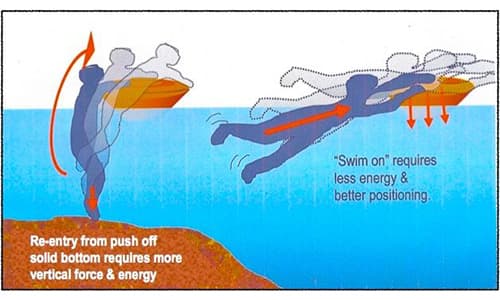
One significantly critical point of practicing self-rescues in a pool is limiting your practice to the shallow, “feet-firmly-planted-on-the-pool-bottom” approach to re-entering your floating kayak. Having solid footing is fine for running through the processes the first few times, and even further when you are practicing your onboard re-entry down into the cockpit. The real test of mastering a re-entry is being able to complete it in deep water, in a more real-life scenario.
We are already compromised in a pool where there’s no reality check with an actual capsizing environment that we’d be in “for real”. At least learning how to re-enter your boat in the deep end of the pool will force you to rely on critical moves rather than “cheat” by pushing up off the bottom. No matter how quickly and smoothly you mastered a re-entry in shallow water, the deep-water session will be a real eye-opener for most.
PADDLE FLOAT RESCUE - This is a basic rescue to learn and the pool is a good place - if - you have the room. One of the biggest dangers for a paddle float rescue in a group setting is what instructors would call “Waving the Flag”. That’s when you overshoot your centering your body over your cockpit/aft deck area and the boat rolls over raising the extended paddle and float up out of the water in a bat-swinging arc that slams back down hard onto the water on the other side of the boat - but hopefully not into another paddler. Again, use spotters!
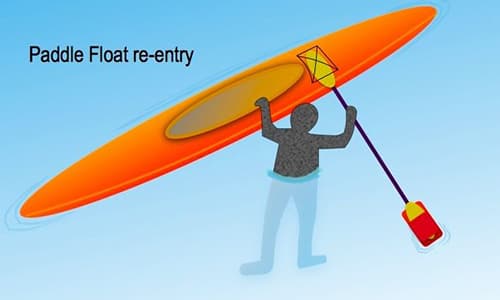
ASSISTED ROLL-UP - is another pool/team rescue you can practice maneuver by yourself as one of your edge exercises and then transfer that skill to the water by using a kayaker alongside (who then basically provides the same support as did the pool’s edge). This technique does also require the skill of re-entering your kayak while it’s overturned. It’s an involved process that has limited applications, but one of the easiest righting techniques on the water.
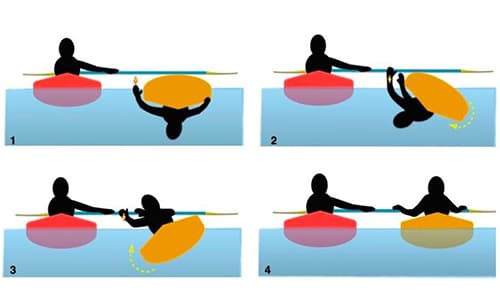
MORE SKILLS - AND FUN…Pool sessions can be a workout. You don’t realize you’re sweating, but you should be tired after a couple of hours of active on-water exercise. Plan to pace yourself with a couple of fun activities in the pool. Perhaps a sculling race or re-entry time race. Or even swimming - but with a paddle!
PADDLE SWIMMING - draws a thin line between rescue technique and gimmick. Essentially it’s swimming by using your paddle as huge extensions of your hands for stroking through the water. It doesn’t take long to master, especially if you’re wearing a PFD for flotation and can concentrate on your kick and forward stroking rhythm or cadence. It’s not nearly as fatiguing at it may sound and the pool offers the perfect conditions for you to see how efficient of a paddle swimmer you might be.

I encourage you to look into pool sessions this winter, a good time to get introduced to skills and techniques to give you more confidence on the water. I also highly recommend Wayne Horodowich’s series of University of Sea Kayaking videos,“Capsize Recoveries & Rescue Procedures” USK Vol 1 & 2 to see more of the techniques applicable to pool sessions.
Most skills and techniques in a pool can be practiced alone, but for safety sake and for sharing knowledge and experiences, use the buddy system. Be safe; Have fun!
Related Articles
Dungeness Spit from above, with the New Dungeness Lighthouse in the distance Dungeness…
Whether you were new to paddling in 2018 or you're an experienced paddler, you can never stop learning.…




